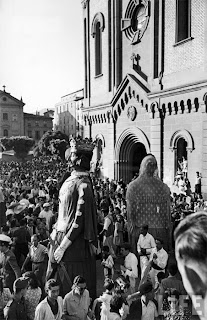Welcome to my blog. Here you can practise and improve your English in a different way. You will find interesting and useful links: culture and history, grammar, phonetic, FCE, vocabulary tasks, texts, videos, songs, English organization…
jueves, 7 de julio de 2016
SANFERMIN GIANTS AND BIGHEADS
HISTORY
According to a rather obscure tradition, during the procession of San Fermín in 1276, three Giants, called, Peru Suziales, Mari Suziales, his wife, and one called Jusef Lukurari (" The Usurer") - a personification of the popular repulsion against the Jews at that time, - were paraded dancing through the streets.
But the first authentic references to The Giants in San Fermin date from the beginning of the XVII century; in 1607 one Joanes de Azcona is named as being responsible for bringing out the assemblage of Giants along with a minstrel who was responsible for providing the accompanying music. In 1620 it is recorded that a carpenter, Joan de Torrobas, was paid 88 "reales" to mend four Giants.
It was the custom around that time to parade Giants in the evenings, after the bullfights, which were adorned with crackers and fireworks,(not unlike the present-day mechanical contrivance of the "Torch Bull" borne by a human) and which were frolicked around the square, before eventually ending up on the bonfire.
This practice of having Giants in the celebrations continued through the greater part of the XVIII century, until in 1780, The King, Carlos III, banned " the use of dancing Giants for leading any religious processions inside or outside all churches within this Kingdom" (by Royal Decree of tenth of July, 1780) which put a stop to the use of any Giants during the San Fermin celebrations. The Giants which had belonged to the Town Hall disappeared without any further trace while the Giants which belonged to the Cathedral were stored away and forgotten about, until 1813 when they were discovered by a carpenter who revived the old tradition by bringing them out once again into the streets. The response was so enthusiastic that The Town Hall gradually built up their own collection of Giants, along with accompanying figures such as the Zaldikos, Kilikis, and Cabezudos.
The Giants that are presently in use date from 1860 and were made by one Tadeo Amorena, a local painter from Pamplona. He presented a scheme to the Town Hall in March of that year to built four new Giants which would represent the "four corners of the world" and which would be more durable and yet lighter than the old ones. A local poet- one Ignacio Baleztena- couldn't help but write some caustic lines on the fact that :
"It seems poor Tadeo had never heard tell of The Oceanic Continent".
The present cabezudos in use were built in 1890 by one Félix Flores. Some of kilikis and zaldikos are from the last century while the rest date from this century.
miércoles, 6 de julio de 2016
SAN FERMIN 6th - 14th JULY
Sanfermin
 The festival of Sanfermín (or Sanfermines) in the city of Pamplona (Navarre, Spain), is a deeply rooted celebration held annually from 12:00, 6 July, when the opening of the fiesta is marked by setting off the pyrotechnic txupinazo, to midnight 14 July, with the singing of the Pobre de Mí.
The festival of Sanfermín (or Sanfermines) in the city of Pamplona (Navarre, Spain), is a deeply rooted celebration held annually from 12:00, 6 July, when the opening of the fiesta is marked by setting off the pyrotechnic txupinazo, to midnight 14 July, with the singing of the Pobre de Mí.
 Sanfermin is internationally known for the event of the running of the bulls, where the bulls are let loose through some of the streets of the old part of the city. The runnings of the bulls take place from the 7th of July to the 14th of July inclusive at 8.00 am in the morning. At midday on the 6th of July the fiestas open with the txupinazo rocket. That day there is no running of the bulls but there sure is a lot of partying. It was thanks to the writing of American writer Ernest Hemingway that San Fermin developed the notoriety of today. The publication of his novel "The Sun Also Rises" in 1926 told the world about the Pamplona bull running festival which attracted people from all over the world to this annual festival.
Sanfermin is internationally known for the event of the running of the bulls, where the bulls are let loose through some of the streets of the old part of the city. The runnings of the bulls take place from the 7th of July to the 14th of July inclusive at 8.00 am in the morning. At midday on the 6th of July the fiestas open with the txupinazo rocket. That day there is no running of the bulls but there sure is a lot of partying. It was thanks to the writing of American writer Ernest Hemingway that San Fermin developed the notoriety of today. The publication of his novel "The Sun Also Rises" in 1926 told the world about the Pamplona bull running festival which attracted people from all over the world to this annual festival.
Riau Riau
Pobre de mí
At midnight on the 14 th July the fiesta formally closes with the ceremony called the "Pobre de Mí."

 The festival of Sanfermín (or Sanfermines) in the city of Pamplona (Navarre, Spain), is a deeply rooted celebration held annually from 12:00, 6 July, when the opening of the fiesta is marked by setting off the pyrotechnic txupinazo, to midnight 14 July, with the singing of the Pobre de Mí.
The festival of Sanfermín (or Sanfermines) in the city of Pamplona (Navarre, Spain), is a deeply rooted celebration held annually from 12:00, 6 July, when the opening of the fiesta is marked by setting off the pyrotechnic txupinazo, to midnight 14 July, with the singing of the Pobre de Mí.  Sanfermin is internationally known for the event of the running of the bulls, where the bulls are let loose through some of the streets of the old part of the city. The runnings of the bulls take place from the 7th of July to the 14th of July inclusive at 8.00 am in the morning. At midday on the 6th of July the fiestas open with the txupinazo rocket. That day there is no running of the bulls but there sure is a lot of partying. It was thanks to the writing of American writer Ernest Hemingway that San Fermin developed the notoriety of today. The publication of his novel "The Sun Also Rises" in 1926 told the world about the Pamplona bull running festival which attracted people from all over the world to this annual festival.
Sanfermin is internationally known for the event of the running of the bulls, where the bulls are let loose through some of the streets of the old part of the city. The runnings of the bulls take place from the 7th of July to the 14th of July inclusive at 8.00 am in the morning. At midday on the 6th of July the fiestas open with the txupinazo rocket. That day there is no running of the bulls but there sure is a lot of partying. It was thanks to the writing of American writer Ernest Hemingway that San Fermin developed the notoriety of today. The publication of his novel "The Sun Also Rises" in 1926 told the world about the Pamplona bull running festival which attracted people from all over the world to this annual festival.
The fiestas are celebrated in honor of Saint Fermin, patron of Navarra, and both the religious elements and the wild partying elements live out the fiestas in good harmony.
The Txupinazo VIDEO 2014
The explosion of the fireworks rocket at midday on the 6th of July is the signal for the start of nine days of non-stop partying. This moment is marked by a rocket - the "Txupinazo" - which is set off to announce the start of the Fiesta.Riau Riau
On the 6th of July, at 4.30 in the afternoon, Sanfermin tradition dictates that everyone should gather for the riau-riau. Nowadays, the motivation is rather different to the original reason.
The municipal band, "La Pamplonesa" played a set piece of music "el Valls de Astráin" and the people danced, sang, drank and blocked the route for as long as possible.
Procession
The 7th of July, at 10.00 am on the day, the procession of Saint Fermin leaves from the church of San Lorenzo. The route is jam-packed with crowds who want to see the image of the saint and the entourage that accompany the figure of the saint.
Bull Running
All the information, photos and videos on the most emblematic event in Sanfermin
The corrida
The corrida or bullfight during San Fermin is very different to bullfights in any other big bullring in Spain or anywhere else. For the simple reason that it is something more than just a bullfight.
Pobre de mí
At midnight on the 14 th July the fiesta formally closes with the ceremony called the "Pobre de Mí."

martes, 5 de julio de 2016
lunes, 4 de julio de 2016
INDEPENDENCE DAY - 4th JULY
 Independence Day in the United States is also known as the Fourth of July. It is a national holiday that commemorates the Declaration of Independence on July 4, 1776. This was the day the USA was born and became independent from Great Britain. The terms “Independence Day” and the “Fourth of July” are a well-known part of the USA’s cultural language. People celebrate with national pride. There are fireworks, parades, sporting events and lots more. It is one of the biggest days on America’s holiday calendar. Politicians make speeches celebrating America’s history and traditions. In particular, attention turns to Thomas Jefferson’s speech that declared the United States of America as an independent nation.
Independence Day in the United States is also known as the Fourth of July. It is a national holiday that commemorates the Declaration of Independence on July 4, 1776. This was the day the USA was born and became independent from Great Britain. The terms “Independence Day” and the “Fourth of July” are a well-known part of the USA’s cultural language. People celebrate with national pride. There are fireworks, parades, sporting events and lots more. It is one of the biggest days on America’s holiday calendar. Politicians make speeches celebrating America’s history and traditions. In particular, attention turns to Thomas Jefferson’s speech that declared the United States of America as an independent nation.
Independence Day is a red, white and blue affair. The whole of the country displays American flags and banners. There are many festivals that enact famous events from America’s history. It is also a day when the nation gets outdoors. Picnics and barbecues with family and friends are the most popular ways to celebrate. In the evening, there are thousands of fireworks displays across the country. One of the most popular is the Macy’s department store show on New York’s East River. This is televised nationwide by the NBC TV channel. Also in New York, you can witness the Hot Dog Eating Contest on Coney Island. Indeed, American food is of course a big part of the day and millions of hot dogs, burgers and pizzas are eaten.

Suscribirse a:
Entradas (Atom)








